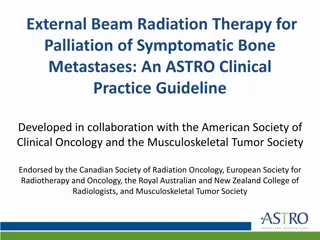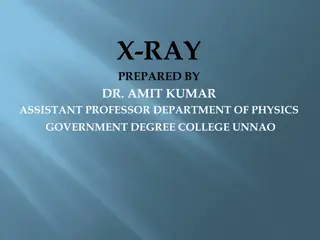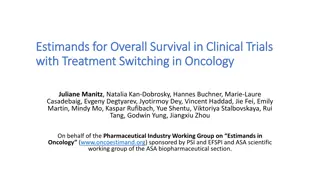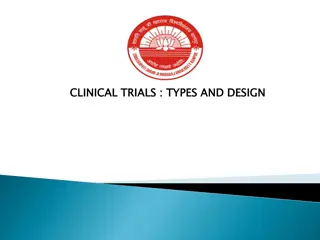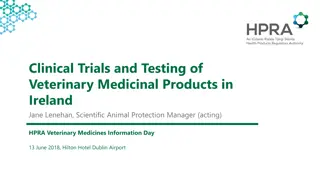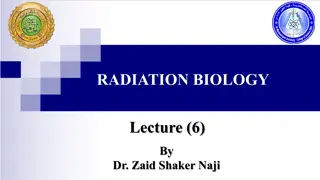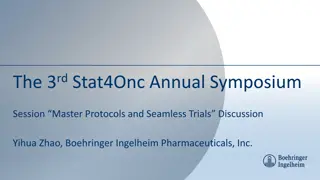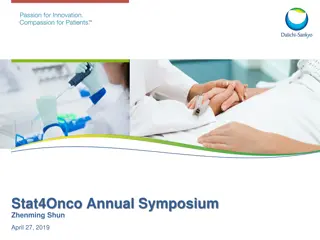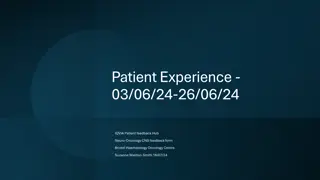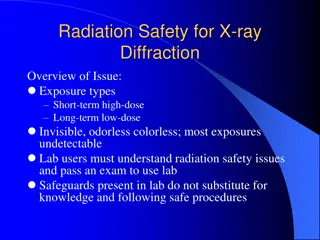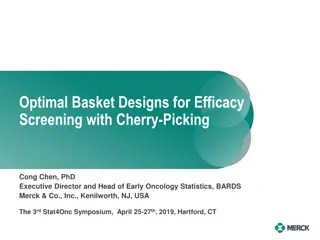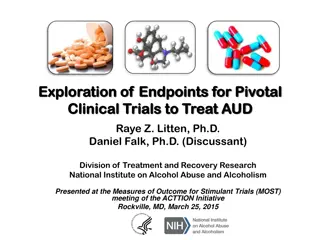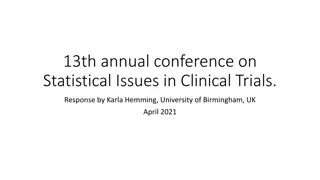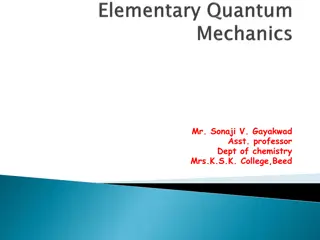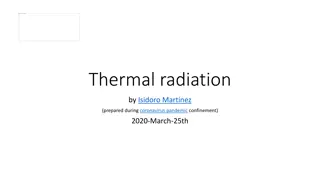Challenges in Oncology Clinical Trials: Balancing Surgical and Radiation Therapies
Comparison between sublobar resection and stereotactic ablative radiotherapy (SAbR) in high-risk patients with stage I non-small cell lung cancer has faced challenges like poor accrual, equipoise concerns among surgeons, and complex eligibility criteria. Traditional phase III trials struggle due to patients' lack of equipoise, leading oncologists to rely on lower-level evidence like retrospective series and matched case cohorts to make treatment decisions in oncology.
Download Presentation

Please find below an Image/Link to download the presentation.
The content on the website is provided AS IS for your information and personal use only. It may not be sold, licensed, or shared on other websites without obtaining consent from the author.If you encounter any issues during the download, it is possible that the publisher has removed the file from their server.
You are allowed to download the files provided on this website for personal or commercial use, subject to the condition that they are used lawfully. All files are the property of their respective owners.
The content on the website is provided AS IS for your information and personal use only. It may not be sold, licensed, or shared on other websites without obtaining consent from the author.
E N D
Presentation Transcript
Example of a Big Title Example of smaller subtitle Radiation Oncology
Protocol Version 5 Jolt-Ca Stablemates A Randomized Phase III Study of Sublobar Resection (SR) versus Stereotactic Ablative Radiotherapy (SAbR) in High Risk Patients with Stage I Non-Small Cell Lung Cancer (NSCLC) 2 Radiation Oncology
Background 3 Radiation Oncology
ACOSOG Z4099/RTOG 1021 PIs: Hiran C. Fernando, MD (ACOSOG); Robert Timmerman, MD (RTOG) Traditional Phase III Randomized Trial Patients randomized to either surgery or SAbR after consent Primary endpoint = 3 year overall survival 4 Radiation Oncology
ACOSOG Z4099/RTOG 1021 Comparing sublobar resection vs. SAbR in specifically high risk operable patients 60 sites opened the trial in the US, Canada, and Europe Poor accrual Extensive investigation regarding barriers to accrual Equipoise of surgeons? Eligibility criteria? Complicated accreditation? Trial was modified to clarify high risk and expand eligibility Finally closed due to poor accrual 5 Radiation Oncology
High Level Trials of Disparate Therapies Often, the MOST IMPORTANT clinical questions in oncology Surgery vs. radiation Observation vs. treatment Patients struggle to allow an indifferent coin flip to solely determine an important decision in their life Patients lack equipoise With failure of traditional phase III trials, oncologists must resort to lower level evidence Retrospective series Matched case cohort 6 Radiation Oncology
Pre-randomization NSABP B-06 trial comparing mastectomy to lumpectomy/XRT had very poor accrual when originally opened for enrollment Threatened closure due to patient refusal to accept the randomization NSABP, with great insight, re-designed the trial to utilize a randomization that occurred prior to asking the patient to participate Screened eligible patients were identified prior to initial visit, randomized, and given the option to accept the randomized assignment Patients refusing the randomized assignment were tracked for primary outcome on standard therapy In the end, patients signed the consent AFTER the randomization The re-design led to successful accrual that allowed the trial to answer the question 80% of screened eligible patients accepted the randomization Well accepted result in the oncology community despite alternate phase III design 7 Radiation Oncology
New Concept Given the progress in site accreditation and buy-in already existing, we are going to re- open the ACOSOG/RTOG trial under the newly formed Joint Lung Cancer Trialist s Coalition (JoLT-Ca) The trial will be supported by industry (Varian, Elekta, and Accuray) Most importantly, the re-designed trial will utilize a pre-randomization to avoid the condemning problem where patients lack equipoise for trials comparing disparate therapies 8 Radiation Oncology
versus Cold Blade? Hot Ray? 9 Radiation Oncology
Schema 10 Radiation Oncology
11 Radiation Oncology
Study Objectives 12 Radiation Oncology
Study Objective To test the hypothesis that overall survival rate in high risk operable patients with Stage I NSCLC is greater in patient who undergo SAbR as compared to standard sublobar resection (SR) 13 Radiation Oncology
Study Endpoints Primary Endpoint Overall survival rate for Stage I NSCLC who undergo SR or SAbR; overall survival will be measured from date of treatment initiation until death Secondary Endpoints Progression free survival for Stage I NSCLC who undergo SR or SAbR. Progression-free survival (PFS) is the time elapsed between treatment initiation and (1) any recurrence (local, regional or distant) or (2) death due to any cause Local and regional recurrence rates for Stage I NSCLC who undergo SR or SAbR. Time to local and regional recurrence is defined per section 10.0 and includes patients with failures of either the primary tumor and/or regional lymph nodes Distant recurrence rates for Stage I NSCLC who undergo SR or SAbR. Time to distant recurrence is defined per section 10.0 for patients with distant failure Assess toxicity using the Common Toxicity Criteria for Stage I NSCLC who undergo SR or SAbR 14 Radiation Oncology
Subject Eligibility 15 Radiation Oncology
Inclusion Criteria (1) Age > 18 years. ECOG/Zubrod performance status (PS) 0, 1, or 2. Radiographic findings consistent with non-small cell lung cancer, including lesions with ground glass opacities with a solid component of 50% or greater. Those with ground glass opacities and <50% solid component will be excluded. The primary tumor in the lung must be biopsy confirmed non-small cell lung cancer within 180 days prior to randomization. Tumor 4 cm maximum diameter, including clinical stage IA and selected IB by PET/CT scan of the chest and upper abdomen performed within 180 days prior to randomization. Repeat imaging within 90 days prior to randomization is recommended for re-staging but is not required based on institutional norms. All clinically suspicious mediastinal N1, N2, or N3 lymph nodes (> 1 cm short-axis dimension on CT scan and/or positive on PET scan) confirmed negative for involvement with NSCLC by one of the following methods: mediastinoscopy, anterior mediastinotomy, EUS/EBUS guided needle aspiration, CT-guided, video-assisted thoracoscopic or open lymph node biopsy within 180 days of randomization. Tumor verified by a thoracic surgeon to be in a location that will permit sublobar resection. 16 Radiation Oncology
Inclusion Criteria (2) Tumor located peripherally within the lung. NOTE: Peripheral is defined as not touching any surface within 2 cm of the proximal bronchial tree in all directions. See below. Patients with non-peripheral (central) tumors are NOT eligible. No evidence of distant metastases. Availability of pulmonary function tests (PFTs spirometry, DLCO, +/- arterial blood gases) within 180 days prior to registration. Patients with tracheotomy, etc, who are physically unable to perform PFTs (and therefore cannot be tested for the Major criteria in 3.1.11 below) are potentially still eligible if a study credentialed thoracic surgeon documents that the patient s health characteristics would otherwise have been acceptable for eligibility as a high risk but nonetheless operable patient (in particular be eligible for sublobar resection). 17 Radiation Oncology
Inclusion Criteria (3) Patient at high-risk for surgery by meeting a minimum of one major criteria or two minor criteria as described below: Major Criteria FEV1 50% predicted (pre-bronchodilator value) DLCO 50% predicted (pre-bronchodilator value) Minor Criteria Age 75 FEV1 51-60% predicted (pre-bronchodilator value) DLCO 51-60% predicted (pre-bronchodilator value) Pulmonary hypertension (defined as a pulmonary artery systolic pressure greater than 40mm Hg) as estimated by echocardiography or right heart catheterization Study credentialed thoracic surgeon believes the patient is potentially operable but that a lobectomy or pneumonectomy would be poorly tolerated by the patient for tangible or intangible reasons. The belief must be declared and documented in the medical record prior to randomization. Poor left ventricular function (defined as an ejection fraction of 40% or less) Resting or Exercise Arterial pO2 55 mm Hg or SpO2 88% pCO2 > 45 mm Hg Modified Medical Research Council (MMRC) Dyspnea Scale 3. Grade Description 0 No breathlessness except with strenuous exercise Breathlessness when hurrying on the level or walking up a slight hill Walks slower than people of the same age on the level because of breathlessness or has to stop for breath when walking at own pace on the level Stops for breath after walking about 100 yards or a few minutes on the level Too breathless to leave the house or breathless when dressing or undressing 1 2 3 4 18 Radiation Oncology
Inclusion Criteria (4) No prior intra-thoracic radiation therapy for previously identified intra-thoracic primary tumor (e.g. previous lung cancer) on the ipsilateral side. NOTE: Previous radiotherapy as part of treatment for head and neck, breast, or other non-thoracic cancer is permitted to the ipsilateral side so long as possible radiation fields would not overlap. NOTE: Radiotherapy to the contralateral lung is allowed so long as it was completed more than 3 years prior to randomization and there is no overlap of radiation fields. Previous chemotherapy, radiotherapy, or surgical resection specifically for the lung cancer being treated on this protocol is NOT permitted. No prior lung resection on the ipsilateral side. Non-pregnant and non-lactating. Women of child-bearing potential must have a negative urine or serum pregnancy test prior to registration. Peri-menopausal women must be amenorrheic > 12 months prior to registration to be considered not of childbearing potential. No prior invasive malignancy, unless disease-free for 3 years prior to registration (exceptions: non- melanoma skin cancer, in-situ cancers). Ability to understand and sign a written informed consent. 19 Radiation Oncology
Patient Registration & Randomization 20 Radiation Oncology
Patient Randomization Once the patient has been confirmed eligible, pre-randomization will be performed without patient involvement The checklist needs to be confirmed and signed/dated by the investigator prior to randomization DO NOT RANDOMIZE UNLESS YOU HAVE A SIGNED/DATED CHECKLIST & supporting documents Uploaded to REDCap within 48 hours of completion Physical eval must be documented in the baseline H&P Randomization will be done using RedCap (web-based data management system) The treating site will obtain a unique identifier for the patient after entering only the patient s age and sex (other information will not be entered at this time) The patient will be randomized to either Surgical Resection (SR) or Radiation (SAbR) Supporting documents for all EC points and consent need to be provided within 2 business days of completion If something is not specified in an office note (i.e. ECOG, and menopause status) it can be specified in a NTF (signed/dated prior to randomization) 21 Radiation Oncology
Patient Registration Patients will be informed of which treatment arm they have been assigned from the pre-randomization If the patient agrees to accept the pre-randomization assignment, they will then receive either SR or SAbR with follow-up per the study calendar (Patient signs consent) If the patient rejects (refuses) to consent to the pre-randomization assignment, they will then be offered follow-up on the trial after standard of care treatment and per the study calendar for progression free and overall survival (intent to treat analysis). (Patient signs consent) Standard of care will be decided by the local team according to their perceptions in conjunction with the patient s condition and wishes. Patients not accepting the pre-randomization assignment will ideally be followed and analyzed to ensure consistency between those accepting and not accepting the assignment. Typically the standard of care treatment will be surgery for most patients. However, if a patient refuses surgery and the local team considers alternate treatments standard in that context, including SBRT, the patient may be enrolled to the observation portion of the study. Patients rejecting (refusing) consent for any study activities will not be followed (lost to follow-up) (Patient does NOT sign consent) All subjects consenting to participate in any aspect of the trial must be registered with the UTSW Rad Oncology CRO through RedCap before initiating protocol activities (aside from the pre-randomization) Source Documentation to confirm eligibility criteria must be uploaded to RedCap within 48 hrs of patient enrollment Any questions regarding patient registration and/or eligibility should be directed to Sarah Hardee Neufeld or Sarmistha Sen 22 Radiation Oncology
Study Calendar 23 Radiation Oncology
24 Radiation Oncology
Study Calendar Patients that Accept Randomization: Follow the study calendar and complete CRFs as needed All questions on all CRFs (except for pregnancy tests for males) need to be answered, even if the answer is No or 0 for AE grades CRFs need to be completed within the 30 days following the visit If insurance will not allow PET scans every 6M they can be substituted with CTs (we just need a note explaining why it is being substituted) Patient Rejects Randomization, but Agree to Follow Up: Follow the study calendar and complete CRFs as needed Pts need to be followed at the minimum of every 6 months (see section 9.5 for more details) CRFs need to be completed within the 30 days following the visit 25 Radiation Oncology
QUALITY ASSURANCE (QA) DOCUMENTATION 26 Radiation Oncology
Surgery QA Documentation Surgical quality assurance will be performed by the surgical study chair or designee and recorded in a study specific surgical QA form (available in RedCap) All operative and pathology reports will be reviewed for success of the resection by the surgical study chair or designee Problems or concerns about investigator performance will be communicated directly to the investigator by the study chair 27 Radiation Oncology
SAbR QA Documentation Recorded in the study specific QA form (available at www.joltca.org) and DICOM RT datasets; which should be submitted to UTSW Radiation Oncology for review. For First Patient: Rapid review of the first SAbR patient s treatment plan prior to treatment is required for each institution; waived if the institution already performed such first case review on one of the following RTOG trials: 0236, 0813, 0618, 0915, and 1021 Prior to the start of SAbR, submit the following materials for the first patient treated at your site: Planning CT images (DICOM) Structure contours (DICOM RT Structure Set) for critical normal structures, all GTV, CTV, and PTV contours (C1, C3) Treatment plan (DICOM RT Plan) for initial and boost beam sets 3-D CALCULATED dose distributions (DICOM RT Dose) for initial and boost sets of concurrently treated beams Color isodose images in axial, sagittal, and coronal planes (JPEG or PNG screen captures) DVH data for all required critical normal structures, GTV, CTV, and PTVs for total dose plan (DV) Digital Data Submission Information Form (DDSI) Note: Prior to data submission, all DICOM objects have to be de-identified with a provided DICOM de- identification tool For All Subsequent Patients: Within four weeks after completion of SAbR, submit the required materials identified in Section 6.6.3 of the Protocol for all patients. Submitted digitally as DICOM RT objects Final dosimetry data submission for all Patients - Within four weeks after completion of SAbR, submit hard copies of Radiotherapy Summary Form The study co-chair or designee will perform retrospective treatment plan review after receipt of complete data for the first 50 cases enrolled 28 Radiation Oncology
SAbR QA Submission Instructions All CT planning and treatment information (e.g., planning CT files, dose files, plan files, and structure files) must be submitted digitally in DICOM RT format; plan report including isodose distributions, DVHs and dose statistics in PDF format shall also be submitted along with digital DICOM RT datasets A Secure FTP (SFTP) account with username and password can be obtained by contacting UT Southwestern Medical Center - Department of Radiation Oncology, Yulong.yan@utsouthwestern.edu Sites must notify via e-mail when digital data are submitted; the e-mail must include the study and patient identification numbers and a description of the datasets being submitted (e.g. QA, SAbR treatment plan, etc.) The jolt webpage (https://www.utsouthwestern.edu/education/medical-school/departments/radiation- oncology/research/clinical/jolt-ca/) has information on submission information as well as links to available information 29 Radiation Oncology
Adverse Events 30 Radiation Oncology
Acute and Late Adverse Events Acute Adverse Events Adverse events occurring in the time period from the signing of the informed consent, through 4 weeks post treatment will be considered acute adverse events. All events that take place during this time duration, no matter the category or relatedness, must be recorded. Late Adverse Events Adverse events occurring in the time period from the end of acute monitoring, to 24 months (2 years) post treatment, will be defined as late adverse events. Visits used for adverse event evaluation include Radiation Oncology and Surgery. Specific events to be evaluated are listed below. 31 Radiation Oncology
Serious Adverse Events ICH Guideline E2A and the UTSW IRB define serious adverse events as those events, occurring at any dose, which meets any of the following criteria: Results in death Immediately life-threatening Results in inpatient hospitalization1,2 or prolongation of existing hospitalization Results in persistent or significant disability/incapacity Results in a congenital anomaly/birth defect Based upon appropriate medical judgment, may jeopardize the subject s health and may require medical or surgical intervention to prevent one of the other outcomes listed in this definition. Note: A Serious adverse event is by definition an event that meets any of the above criteria. Serious adverse events may or may not be related to the research project. A serious adverse event determination does not require the event to be related to the research. That is, both events completely unrelated to the condition under study and events that are expected in the context of the condition under study may be serious adverse events, independent of relatedness to the study itself. As examples, a car accident requiring >24 hour inpatient admission to the hospital would be a serious adverse event for any research participant; likewise, in a study investigating end-stage cancer care, any hospitalization or death which occurs during the protocol-specified period of monitoring for adverse and serious adverse events would be a serious adverse event, even if the event observed is a primary clinical endpoint of the study. 1Pre-planned hospitalizations or elective surgeries are not considered SAEs. Note: If events occur during a pre-planned hospitalization or surgery, that prolong the existing hospitalization, those events should be evaluated and/or reported as SAEs. 2 NCI defines hospitalization for expedited AE reporting purposes as an inpatient hospital stay equal to or greater than 24 hours. Hospitalization is used as an indicator of the seriousness of the adverse event and should only be used for situations where the AE truly fits this definition and NOT for hospitalizations associated with less serious events. For example: a hospital visit where a patient is admitted for observation or minor treatment (e.g. hydration) and released in less than 24 hours. Furthermore, hospitalization for pharmacokinetic sampling is not an AE and therefore is not to be reported either as a routine AE or in an expedited report. 32 Radiation Oncology
Steps to Determine if AE Requires Expedited Reporting (1) Step 1: Identify the type of adverse event using the NCI Common Terminology Criteria for Adverse Events (CTCAE v4). Step 2: Grade the adverse event using the NCI CTCAE v4. Step 3: Determine whether the adverse event is related to the protocol therapy. Attribution categories are as follows: Definite The AE is clearly related to the study treatment. Probable The AE is likely related to the study treatment. Possible The AE may be related to the study treatment. Unlikely The AE may NOT berelated to the study treatment. Unrelated The AE is clearly NOT related to the study treatment. Note: This includes all events that occur to the end of the acute adverse events reporting period as defined in section 11.4.1). Any event that occurs more than 30 days after the last dose of treatment during the late adverse event period as defined in section 11.4.1 and is attributed (possibly, probably, or definitely) to the agent(s) must also be reported as indicated in the sections below. Step 4: Determine the prior experience of the adverse event. Expected events are those that have been previously identified as resulting from administration of the treatment. An adverse event is considered unexpected, for expedited reporting purposes only, when either the type of event or the severity of the event is not listed in: the current known adverse events listed in the Agent Information Section of this protocol (if applicable); the drug package insert (if applicable); the current Investigator s Brochure (if applicable) the Study Agent(s)/Therapy(ies) Background and Associated Known Toxicities section of this protocol 33 Radiation Oncology
Steps to Determine if AE Requires Expedited Reporting (2) Serious Adverse Events (anticipated as reflected by warnings of the informed consent) must be submitted within 2 working days of the participating site PI s awareness Unanticipated Problems (unanticipated SAEs as defined above) must be submitted within 1 working day of the participating site PI s awareness Reporting Contact: Email: Vaidehi.Chemburkar Vaidehi.Chemburkar @UTSouthwestern.edu Fax: 214-645-8913 34 Radiation Oncology
Questions? SIV follow-up Q&A discussions can be scheduled as needed. If you would like to schedule a Q&A discussion or have any questions, please email Vaidehi Chemburkar at: Vaidehi.Chemburkar@UTSouthwestern.edu REDCap training presentation is separate 35 Radiation Oncology



